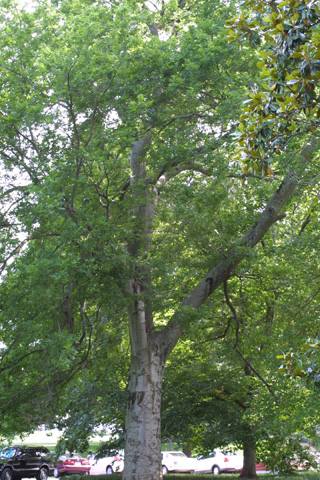
|

|

|

|
An individual instance of Celtis laevigata (sugarberry)

Permanent unique identifier for this particular organism:
http://bioimages.vanderbilt.edu/vanderbilt/12-189
Notes:
This large tree with mostly smooth bark is near the edge of the open area in the southwest corner of Magnolia Lawn. The path from the Bridge to the Commons passes near it.
Hackberry leaves have somewhat uneven leaf bases, a characteristic they share with other members of the elm family. Unlike elms, they have single teeth or no teeth at all. As their name suggests, hackberry fruits are fleshy berries, in contrast to the dry, winged seeds of elms. Perhaps the most noticeable characteristic of hackberries is their bark. Overall, they tend to have smooth bark, similar to beech bark. However, hackberry bark nearly always few to many corky lumps scattered throughout the smooth bark, which is rarely the case with beech.
Two species of hackberry are commonly found in Tennessee: southern hackberry or sugarberry ( Celtis laevigata ), and northern hackberry ( Celtis occidentalis ). In this area of range overlap the two species hybridize, so it is often not possible to unambiguously assign an individual tree to a particular species. This individual has characteristics most typical of southern hackberry: relatively narrow leaves with few or no teeth (vs. the rounder, more toothed leaves of northern hackberry) and fruits that are more orange-red (vs. the dark red to black fruits of northern hackberry). An individual with northern hackberry traits can be seen along 21st Ave. S.
Hackberry trees are common in this area with Celtis laevigata types the most common.
Hackberry leaves have somewhat uneven leaf bases, a characteristic they share with other members of the elm family. Unlike elms, they have single teeth or no teeth at all. As their name suggests, hackberry fruits are fleshy berries, in contrast to the dry, winged seeds of elms. Perhaps the most noticeable characteristic of hackberries is their bark. Overall, they tend to have smooth bark, similar to beech bark. However, hackberry bark nearly always few to many corky lumps scattered throughout the smooth bark, which is rarely the case with beech.
Two species of hackberry are commonly found in Tennessee: southern hackberry or sugarberry ( Celtis laevigata ), and northern hackberry ( Celtis occidentalis ). In this area of range overlap the two species hybridize, so it is often not possible to unambiguously assign an individual tree to a particular species. This individual has characteristics most typical of southern hackberry: relatively narrow leaves with few or no teeth (vs. the rounder, more toothed leaves of northern hackberry) and fruits that are more orange-red (vs. the dark red to black fruits of northern hackberry). An individual with northern hackberry traits can be seen along 21st Ave. S.
Hackberry trees are common in this area with Celtis laevigata types the most common.

|

|
|
Load database and switch to thumbnail view
Use this stable URL to link to this page:
http://bioimages.vanderbilt.edu/vanderbilt/12-189.htm
This organism is a living specimen that is part of the Vanderbilt University Arboretum with the local identifier 1-64.
This particular organism is believed to have managed means of establishment.
This organismal entity has the scope: multicellular organism.
Identifications:
Celtis laevigata
Willd.
sec. fna.org 1993
common name: sugarberry
family: Ulmaceae
Identified 2002-06-11 by Steven J. Baskauf
Location:
Vanderbilt University, Nashville, Davidson County, Tennessee, US
Click on these geocoordinates to load a map showing the location: 36.14307°, -86.79879°
Coordinate uncertainty about: 10 m.
Location of individual determined from GIS database.
Occurrences were recorded for this particular organism on the following dates:
2002-06-11
2003-07-09
2006-04-07
The following images document this particular organism.
Click on a thumbnail to view the image and its metadata. Load database and enable navigation by taxon and organism.






